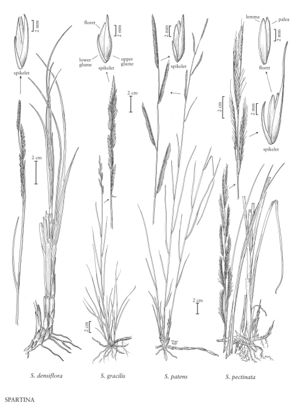Difference between revisions of "Spartina pectinata"
FNA>Volume Importer |
RevisionBot (talk | contribs) m (Bot: Adding category Revised Since Print) |
||
| (4 intermediate revisions by 2 users not shown) | |||
| Line 4: | Line 4: | ||
|publications= | |publications= | ||
|common_names=Prairie cordgrass;Spartine pectinee | |common_names=Prairie cordgrass;Spartine pectinee | ||
| + | |special_status={{Treatment/ID/Special_status | ||
| + | |code=E | ||
| + | |label=Endemic | ||
| + | }} | ||
|basionyms= | |basionyms= | ||
|synonyms={{Treatment/ID/Synonym | |synonyms={{Treatment/ID/Synonym | ||
| Line 20: | Line 24: | ||
-->{{Treatment/Body | -->{{Treatment/Body | ||
| − | |distribution=Conn.;N.J.;N.Y.;Wash.;Del.;D.C;Wis.;W.Va.;Colo.;Alta.;Man.;N.B.;Nfld. | + | |distribution=Conn.;N.J.;N.Y.;Wash.;Del.;D.C.;Wis.;W.Va.;Colo.;Alta.;Man.;N.B.;Nfld. and Labr. (Labr.);N.S.;N.W.T.;Ont.;P.E.I.;Que.;Sask.;N.H.;N.Mex.;Tex.;La.;N.C.;Idaho;Tenn.;Pa.;Wyo.;R.I.;Va.;Mass.;Maine;Vt.;Kans.;N.Dak.;Nebr.;Okla.;S.Dak.;Ark.;Ill.;Ind.;Iowa;B.C.;Minn.;Ohio;Oreg.;Md.;Utah;Mo.;Mich.;Mont.;Ky. |
|discussion=<p><i>Spartina pectinata</i> is native to Canada and the United States, but it has been introduced at scattered locations on other continents. On the Atlantic coast, it grows in marshes, sloughs, and flood plains, being a common constituent of ice-scoured zones of the northeast and growing equally well in salt and fresh water habitats. In western North America, it grows in both wet and dry soils, including dry prairie habitats and along roads and railroads.</p><!-- | |discussion=<p><i>Spartina pectinata</i> is native to Canada and the United States, but it has been introduced at scattered locations on other continents. On the Atlantic coast, it grows in marshes, sloughs, and flood plains, being a common constituent of ice-scoured zones of the northeast and growing equally well in salt and fresh water habitats. In western North America, it grows in both wet and dry soils, including dry prairie habitats and along roads and railroads.</p><!-- | ||
--><p><i>Spartina pectinata</i> is thought to be one of the parents of <i>S. xcaespitosa</i>, the other parent being <i>S. patens</i>.</p> | --><p><i>Spartina pectinata</i> is thought to be one of the parents of <i>S. xcaespitosa</i>, the other parent being <i>S. patens</i>.</p> | ||
| Line 39: | Line 43: | ||
|illustrator=Linda A. Vorobik;Linda Bea Miller | |illustrator=Linda A. Vorobik;Linda Bea Miller | ||
|illustration copyright=Utah State University | |illustration copyright=Utah State University | ||
| − | |distribution=Conn.;N.J.;N.Y.;Wash.;Del.;D.C;Wis.;W.Va.;Colo.;Alta.;Man.;N.B.;Nfld. | + | |distribution=Conn.;N.J.;N.Y.;Wash.;Del.;D.C.;Wis.;W.Va.;Colo.;Alta.;Man.;N.B.;Nfld. and Labr. (Labr.);N.S.;N.W.T.;Ont.;P.E.I.;Que.;Sask.;N.H.;N.Mex.;Tex.;La.;N.C.;Idaho;Tenn.;Pa.;Wyo.;R.I.;Va.;Mass.;Maine;Vt.;Kans.;N.Dak.;Nebr.;Okla.;S.Dak.;Ark.;Ill.;Ind.;Iowa;B.C.;Minn.;Ohio;Oreg.;Md.;Utah;Mo.;Mich.;Mont.;Ky. |
|reference=None | |reference=None | ||
|publication title= | |publication title= | ||
|publication year= | |publication year= | ||
| − | |special status= | + | |special status=Endemic |
| − | |source xml=https:// | + | |source xml=https://bitbucket.org/aafc-mbb/fna-data-curation/src/200273ad09963decb8fc72550212de541d86569d/coarse_grained_fna_xml/V25/V25_865.xml |
|subfamily=Poaceae subfam. Chloridoideae | |subfamily=Poaceae subfam. Chloridoideae | ||
|tribe=Poaceae tribe Cynodonteae | |tribe=Poaceae tribe Cynodonteae | ||
| Line 51: | Line 55: | ||
}}<!-- | }}<!-- | ||
| − | -->[[Category:Treatment]][[Category:Spartina]] | + | --> |
| + | |||
| + | [[Category:Treatment]] | ||
| + | [[Category:Spartina]] | ||
| + | [[Category:Revised Since Print]] | ||
Latest revision as of 17:30, 28 May 2021
Plants strongly rhizomatous; rhizomes elongate, (2)3-8 mm thick, purplish-brown or light brown (drying white), scales closely imbricate. Culms to 250 cm tall, 2.5-11 mm thick, solitary or in small clumps, indurate. Sheaths mostly glabrous, throats often pilose; ligules 1-3 mm; blades 20-96 cm long, 5-15 mm wide, flat when fresh, becoming involute when dry, glabrous on both surfaces, margins strongly scabrous, blade of the second leaf below the panicles 32-96 cm long, 5-14 mm wide, usually involute. Panicles 10-50 cm, not smooth in outline, with 5-50 branches; branches 1.5-15 cm, appressed to somewhat spreading, with 10-80 spikelets. Spikelets 10-25 mm. Glumes shortly awned, glabrous or sparsely hispidulous; lower glumes 5-10 mm, from 3/4 as long as to equaling the adjacent lemmas, keels hispid, apices awned; upper glumes 10-25 mm (including the awn), exceeding the florets, glabrous or sparsely hispid, keels scabrous to hispid, trichomes about 0.3 mm, lateral veins usually glabrous (rarely hispid), on either side of, and close to, the keels, apices awned, awns 3-8 mm; lemmas glabrous, keels pectinate distally, apices bilobed, lobes 0.2-0.9 mm; anthers 4-6 mm, well-filled, dehiscent. 2n = 40, 40+1, 80.
Distribution
Conn., N.J., N.Y., Wash., Del., D.C., Wis., W.Va., Colo., Alta., Man., N.B., Nfld. and Labr. (Labr.), N.S., N.W.T., Ont., P.E.I., Que., Sask., N.H., N.Mex., Tex., La., N.C., Idaho, Tenn., Pa., Wyo., R.I., Va., Mass., Maine, Vt., Kans., N.Dak., Nebr., Okla., S.Dak., Ark., Ill., Ind., Iowa, B.C., Minn., Ohio, Oreg., Md., Utah, Mo., Mich., Mont., Ky.
Discussion
Spartina pectinata is native to Canada and the United States, but it has been introduced at scattered locations on other continents. On the Atlantic coast, it grows in marshes, sloughs, and flood plains, being a common constituent of ice-scoured zones of the northeast and growing equally well in salt and fresh water habitats. In western North America, it grows in both wet and dry soils, including dry prairie habitats and along roads and railroads.
Spartina pectinata is thought to be one of the parents of S. xcaespitosa, the other parent being S. patens.
Selected References
None.
